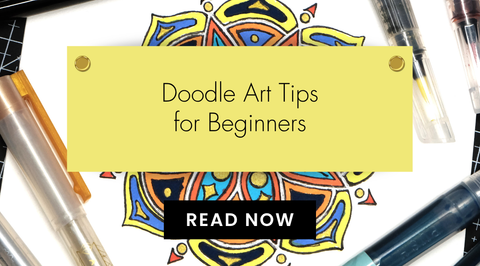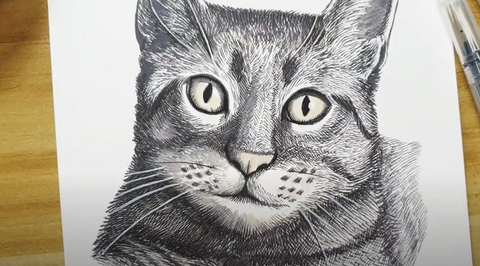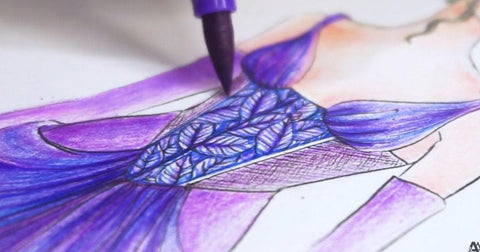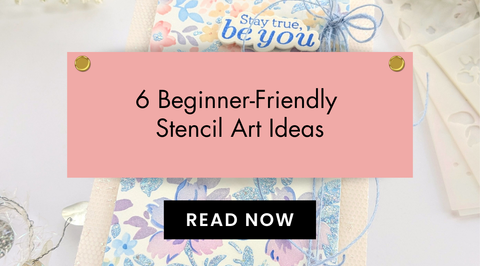Portraiture Magic: How to Nail the Art of Capturing People in Your Artwork
Last Updated: July 29, 2024
“There could never be a portrait of my love, for nobody could paint a dream.” - Matt Monro
Hello, artist friends! Today, let's chat about something as cool as painting but with a little extra flair – portraiture.

Portraiture is the artistic practice of creating portraits – visual representations of individuals. These representations can take various forms, including paintings, drawings, sculptures, photographs, or any other visual medium. The primary goal of portraiture is to capture and convey the likeness, personality, and often the mood or essence of the subject.
Whether you're a seasoned artist or have just picked up a drawing implement, capturing the vibe of a person on canvas is like bottling lightning. But don’t fret – here are some tips and tricks to help you nail the art of capturing the essence of a person on canvas.
Get Friendly with Faces

So, you've got your canvas, your drawing implements, and your artistic enthusiasm in tow. Now, let's talk faces. Faces are like a canvas within a canvas, each with its unique topography waiting for you to explore. Here's the lowdown:
Learn the Landscape
Just like navigating a new city, familiarize yourself with the nooks and crannies of facial anatomy. Dive into the intricate world of cheekbones, jawlines, and the curvature of lips. Knowing the landscape is like having a map for your artistic journey.
Eyes: The Gatekeepers of the Soul
Eyes are the showstoppers, the real headliners of any portrait. Dive deep into the mechanics of eyes – how they convey emotions, the interplay of light, and the subtle reflections that give them life.

Think of eyes as the gatekeepers of the soul; understand them, and you hold the key to unlocking the depth of your subject. When you get the eyes right, you’ve practically hit the jackpot. It’s like the secret sauce of portraiture, so don’t skimp on it!
Noses and Mouths: The Character Builders
Noses and mouths bring character to the party. Study the variety of shapes, sizes, and expressions. A slight curve of the lips or the contour of a nose can tell a story in itself. Don’t be afraid to experiment and exaggerate a bit – after all, this is your artistic playground.
Ears: The Unsung Heroes
Ears often play second fiddle, but they contribute to the symphony of the face. Pay attention to their shapes, sizes, and how they align with the features around them. Ears are like the supporting actors; they may not be in the limelight, but they play a crucial role in the overall composition.
Faces Tell Stories

Every face has a story to tell, and your job as an artist is to be a visual storyteller. Capture the essence of your subject, their history, and the emotions etched on their face. Whether it's a subtle smile, a furrowed brow, or laugh lines that tell tales of joy, these are the elements that make your portrait more than just a likeness – it becomes a narrative.
Let There Be Light (But Make It Cool)
Lighting is like the DJ at the party – it sets the vibe. So, experiment with it! Play around with shadows, throw in some highlights, and let the dance floor be your canvas.

Good lighting can turn a regular portrait into a blockbuster hit. It’s what started the Impressionist movement in the first place, when Claude Monet himself played around with lighting and how light creates interesting shadows and brilliant colors. Throw in some artistic renderings of light in your artwork, and see the magic unfold.
Here, take a look at how considering lighting can help you create 3D images in your art in this tutorial video:
Brush It Like You Mean It
If you’re working with brushes, remember that your brush is your dance partner, and the canvas is your dance floor. Experiment with different strokes, sizes, and textures. Don't be afraid to let your brushes shimmy and shake on that canvas – after all, it's a party, and your brushes are the life of it.
1. Learn to Mix and Match.
Think of your brushes as a diverse group of friends. They all bring something unique to the table. Mix and match them like you're creating the guest list for the most epic party. Combine wide strokes with delicate details, and soft brushes with coarse ones. The magic often happens when you let different brushes collaborate on the canvas.

Cat Painting by Aleksandra Pender
2. Spontaneity is Your BFF.
Don't overthink it; let spontaneity be your best friend forever. Sometimes the most magical strokes happen when you go with the flow. Let your hand move freely, allowing your brushes to create happy accidents. Those unexpected moments can be the highlight of your artistic journey.
3. Texture Is Tantalizing.
Texture adds spice to your artistic dish. Experiment with brushes that create unique textures – from smooth gradients to bold strokes. Texture not only adds visual interest but can also convey emotions and depth. Don't shy away from giving your portrait that tactile, almost 3D feel.

4. Be Bold – Don't Hold Back.
Your brushes are not here to be wallflowers; they want to party! Be bold, be daring. Apply confident strokes, layer colors with gusto, and don't hold back. Your canvas can handle it. A portrait is not just a picture; it's an expression of your artistic boldness, so let your brushes scream it from the canvas.
Colors: Be the Picasso of Your Palette
Your color palette is like a box of magical crayons waiting to bring your canvas to life. Inject some color therapy into your portraits:

Skin Tones: Beyond the Basics
Skin tones are the heart and soul of any portrait. But here's the thing – they're not just beige and brown. Explore the vast spectrum of colors that make up the human complexion. Mix and match hues to create depth and variation. Experiment with undertones – warm pinks, cool blues – to capture the subtle nuances of skin.
Shadows and Highlights – The Drama Makers
Shadows and highlights are like the supporting actors in your color palette drama. They add depth, drama, and that extra oomph to your artwork. Don't be afraid to push the boundaries – deepen the shadows and let the highlights shine. This dynamic interplay of light and dark will make your portrait pop.
Mood-setting Colors
Colors set the mood of your artwork, like the background music of a film. Consider the emotional tone you want to convey. Is it warm and inviting? Cool and mysterious? Play with a variety of color temperatures to evoke specific emotions. Be the director of your color film, shaping the atmosphere with your palette.

Taehyung Fan Art by Aleksandra Pender
Unexpected Color Pops
Picasso was a master at throwing unexpected colors into the mix, and you can be too. Introduce pops of unexpected colors into your portrait – a vibrant background, a splash of color in the eyes, or even unconventional hues for clothing. These unexpected color choices can add an element of surprise and make your portrait stand out.
Learn The Art of Ombré: Tips for Creating Beautiful Gradations of Color in Your Artwork
Capture the Essence of a Person in Your Art Today
Remember, portraiture is like a wild roller coaster ride – sometimes unpredictable, often thrilling. So, loosen up, enjoy the process, and let your artistic mojo flow.
And if you run out of ideas and inspiration, meet us in The Creative Corner, and we’ll be happy to help. Happy painting!






